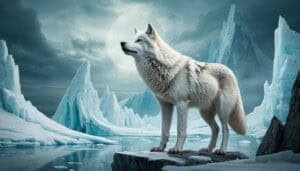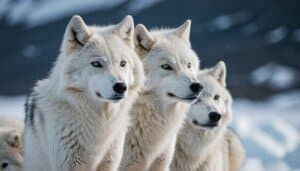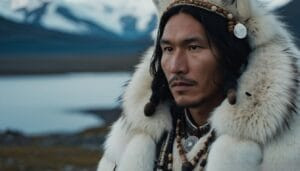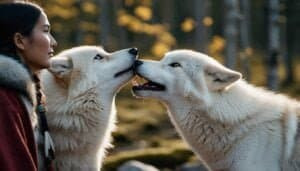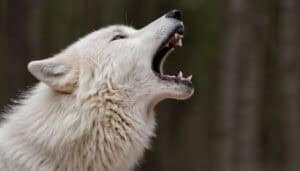Introduction
The spiritual significance of Arctic wolves in the practices of Arctic peoples is profound and multifaceted. This article delves into the rich tapestry of myths and legends surrounding these majestic animals, explores their symbolic meanings, and examines their roles in rituals and shamanic practices
Additionally, we will look at the historical and cultural influence of Arctic wolves, their representation as totems and spirit animals, and how conservation efforts are intertwined with spiritual beliefs
Through this comprehensive exploration, we aim to illuminate the deep spiritual connection between Arctic wolves and Arctic peoples
Mythology and Symbolism
The mythology and symbolism of Arctic wolves are deeply embedded in the spiritual traditions of Arctic peoples
These majestic creatures are revered for their strength, resilience, and mystical qualities. By examining the myths, legends, and symbolic meanings associated with Arctic wolves, we can gain a deeper understanding of their spiritual significance
Myths and Legends Involving Arctic Wolves
Arctic wolves feature prominently in the myths and legends of various Arctic cultures, including the Inuit, Sami, and Chukchi peoples. These stories often depict the wolves as powerful and wise beings with a deep connection to the spiritual world
One common theme in these myths is the wolf as a guide or guardian, leading lost souls or hunters through the harsh Arctic landscape
In Inuit mythology, for example, the wolf is often seen as a symbol of endurance and survival. One popular legend tells of a great wolf spirit that guides hunters, ensuring their safety and success. This spirit is believed to possess the ability to traverse the physical and spiritual realms, providing protection and guidance
Similarly, the Sami people have legends that highlight the wolf’s role as a mediator between the human and spiritual worlds. In these stories, the wolf often serves as a messenger, carrying prayers and offerings to the gods
The wolf’s keen senses and ability to navigate the Arctic terrain are seen as gifts from the divine, further solidifying its spiritual importance
Spiritual and Cultural Symbolism
The spiritual and cultural symbolism of Arctic wolves extends beyond mythology, permeating various aspects of Arctic peoples’ lives. The wolf is often viewed as a symbol of strength, loyalty, and intuition
These qualities are highly valued in Arctic communities, where survival often depends on cooperation, resilience, and a deep connection to the natural world
In spiritual practices, the Arctic wolf is frequently invoked as a totem or spirit animal. Totems are considered to be spiritual beings, animals, or symbols that serve as emblems for individuals, families, or tribes. For many Arctic peoples, the wolf totem represents a source of strength, guidance, and protection
It is believed that those who have the wolf as their totem animal possess qualities such as courage, intuition, and the ability to form strong bonds with others
Additionally, the Arctic wolf is often associated with the concept of the “lone wolf” in cultural symbolism. This archetype represents independence, self-reliance, and the ability to thrive in solitude. While the lone wolf is capable of surviving on its own, it also embodies the importance of finding a balance between independence and community
This duality is reflected in the social structures of Arctic communities, where individual strength is valued, but cooperation and mutual support are essential for survival
Overall, the mythology and symbolism of Arctic wolves provide a rich tapestry of spiritual meanings that continue to influence the cultural and spiritual practices of Arctic peoples. These majestic animals are revered not only for their physical attributes but also for the deeper spiritual connections they represent, serving as powerful symbols of endurance, guidance, and unity
Rituals and Shamanic Practices
Arctic wolves hold a significant place in the rituals and shamanic practices of Arctic peoples. These practices, deeply rooted in ancient traditions, often feature the wolf as a central figure, symbolizing spiritual guidance and strength
Understanding these rituals and shamanic roles offers insight into the profound spiritual connection between Arctic wolves and Arctic communities
Rituals and Ceremonial Uses
Arctic wolves are frequently included in various rituals and ceremonies, often symbolizing protection, guidance, and the embodiment of spiritual power. These rituals are designed to honor the wolf and invoke its qualities for the benefit of the community
In many Arctic cultures, ceremonies involving the Arctic wolf are conducted during important life events, such as births, initiations, and marriages
For instance, during a rite of passage, a young person may be given a wolf totem or symbol to wear, signifying their transition into adulthood and their connection to the wolf’s qualities of resilience and strength
Seasonal ceremonies also highlight the Arctic wolf’s importance. During the long winter months, when survival is particularly challenging, rituals invoking the wolf’s spirit are performed to seek protection and success in hunting. These rituals often involve offerings, chants, and dances that mimic the movements and behaviors of wolves, believed to attract the wolf’s spirit and blessings
The use of wolf pelts, bones, and other parts in ceremonial attire and tools further underscores the spiritual significance of the wolf. Shamans and spiritual leaders wear these items to symbolize their connection to the wolf and to harness its spiritual power during rituals
Role in Shamanism and Spirit Communication
In the shamanic practices of Arctic peoples, the Arctic wolf is seen as a powerful spirit guide and protector. Shamans, who act as intermediaries between the physical and spiritual worlds, often call upon the wolf spirit for assistance in healing, divination, and protection
One of the key roles of the Arctic wolf in shamanism is as a guide during spiritual journeys. Shamans enter trance states to travel to the spirit world, seeking guidance and knowledge. The wolf spirit is believed to lead and protect the shaman through these journeys, ensuring safe passage and successful communication with other spirits
The wolf’s keen senses and hunting abilities are also symbolically important in shamanic practices
Shamans emulate these traits to “hunt” for spiritual insights and to navigate the unseen realms. The wolf’s intuition and sharp instincts are qualities that shamans strive to cultivate, enhancing their ability to perceive and interpret spiritual messages
Additionally, the Arctic wolf is often invoked in healing rituals. Shamans believe that the wolf’s spirit can help identify and remove spiritual ailments, guiding the afflicted person towards recovery. The wolf’s association with endurance and survival makes it an ideal symbol for overcoming physical and spiritual challenges
Arctic peoples also believe in the concept of animal spirits as guardians. Families or individuals may have a particular affinity with the wolf spirit, seeking its protection and blessings
This belief is reflected in household rituals and personal totems that honor the wolf and invite its presence into their lives
Historical and Cultural Influence
The historical and cultural influence of Arctic wolves on Arctic peoples is profound, shaping their worldviews, social structures, and traditions. By examining the historical significance and cultural beliefs associated with Arctic wolves, we can better understand how these animals have impacted and enriched the lives of Arctic communities
Historical Significance
Historically, Arctic wolves have played a crucial role in the survival and cultural development of Arctic peoples. These animals have been both a symbol of resilience and a practical part of daily life in the harsh Arctic environment
In ancient times, Arctic wolves were admired for their ability to thrive in extreme conditions. This admiration translated into a deep respect and a desire to emulate the wolf’s endurance and adaptability
Historical records and oral traditions indicate that Arctic peoples often looked to wolves for inspiration in their own survival strategies. The wolves’ hunting techniques, social organization, and ability to withstand harsh weather were studied and incorporated into human practices
Wolves also played a significant role in the subsistence strategies of Arctic peoples. The relationship between humans and wolves was complex, often characterized by both competition and cooperation. While wolves were competitors for game, they were also considered partners in maintaining the balance of the ecosystem
Arctic peoples respected the wolves’ role in the natural order and believed that coexisting with them was essential for the health of the land and its inhabitants
Moreover, historical artifacts such as tools, clothing, and art often feature wolf motifs, indicating the cultural importance of these animals. Wolf pelts were used for warmth, their bones for tools, and their imagery for decorative and spiritual purposes
This utilization underscores the integral role that Arctic wolves played in the material and spiritual culture of Arctic communities
Cultural Beliefs and Inspirations
Cultural beliefs about Arctic wolves are deeply embedded in the identities and practices of Arctic peoples. These beliefs highlight the wolves’ roles as spiritual guides, symbols of strength, and exemplars of important values
One prominent cultural belief is the notion of kinship between humans and wolves. Arctic peoples often see themselves as spiritually connected to wolves, viewing these animals as relatives or ancestors. This belief is reflected in stories and traditions that emphasize the shared characteristics and destinies of humans and wolves.
Arctic wolves are also seen as teachers, embodying qualities that Arctic peoples strive to emulate. The wolves’ loyalty, cooperation, and strategic thinking are admired and incorporated into human social structures
For example, the strong family bonds observed in wolf packs are mirrored in the close-knit communities of Arctic peoples, where cooperation and mutual support are essential for survival
The behavior of Arctic wolves also inspires cultural practices and rituals. Wolves are known for their hunting skills and keen senses, which are qualities that Arctic hunters aim to replicate. Stories of wolves’ hunting strategies and their ability to navigate the Arctic landscape are passed down through generations, providing valuable lessons and reinforcing the cultural importance of these animals
Additionally, the Arctic wolf is a powerful symbol in artistic expressions. Traditional art, dance, and storytelling often feature the wolf, celebrating its role in the natural and spiritual world. These cultural expressions not only honor the wolf but also reinforce its significance in the community’s identity and values
Totems, Spirit Animals, and Conservation
The connection between Arctic wolves and Arctic peoples extends into the realms of totemism, spirit animals, and conservation
These aspects highlight the deep spiritual and cultural bonds that Arctic communities have with wolves, emphasizing the importance of these animals not only in their spiritual practices but also in their efforts to preserve the natural environment
Totems and Spirit Animal Representation
In Arctic cultures, the concept of totems and spirit animals plays a significant role in the spiritual lives of individuals and communities. The Arctic wolf is a prominent totem and spirit animal, symbolizing various attributes that are highly valued by Arctic peoples
A totem is considered a spiritual emblem that represents a group, such as a family or tribe, and embodies the qualities and values that the group aspires to. The Arctic wolf totem is revered for its strength, loyalty, and intuition
Those who identify with the wolf totem believe that they are blessed with the wolf’s protective and guiding spirit, which helps them navigate life’s challenges
Spirit animals, on the other hand, are believed to be guides that provide individuals with spiritual guidance and support. The Arctic wolf, as a spirit animal, is seen as a source of wisdom and a protector. People who feel a strong connection with the wolf spirit often seek its guidance in times of need, relying on its intuitive and resilient nature
Rituals involving totems and spirit animals are common in Arctic communities. These rituals may include invoking the wolf’s spirit through chants, dances, and offerings
By honoring the wolf totem or spirit animal, individuals and communities strengthen their spiritual bond with the wolf and seek its blessings and protection
Additionally, the presence of the Arctic wolf in dreams and visions is often interpreted as a sign of the wolf’s spiritual presence. Such experiences are considered significant and are used to gain insights into personal and communal matters. The wolf’s appearance in these contexts is seen as a message from the spiritual realm, guiding and advising those who receive it
Conservation Efforts and Spiritual Connections
The spiritual connection between Arctic peoples and Arctic wolves extends to conservation efforts, reflecting a deep respect for these animals and a commitment to their preservation. Arctic communities recognize the importance of maintaining the natural balance and protecting the ecosystems that sustain both humans and wolves
Conservation efforts in Arctic regions are often driven by traditional ecological knowledge, which emphasizes the interconnectedness of all living beings. Arctic peoples view the conservation of wolves as integral to the health of the environment and the well-being of their communities
This perspective is rooted in their spiritual beliefs, which hold that all creatures are part of a sacred web of life
Many Arctic communities actively participate in conservation programs aimed at protecting Arctic wolves and their habitats. These programs include monitoring wolf populations, protecting critical habitats, and advocating for policies that reduce human impact on the environment
By combining traditional knowledge with modern conservation practices, Arctic peoples strive to ensure the survival of Arctic wolves for future generations
Educational initiatives are also an important part of conservation efforts. Arctic communities work to raise awareness about the cultural and spiritual significance of wolves, highlighting the need to preserve these animals as part of their heritage. By educating others about the spiritual connections between humans and wolves, Arctic peoples foster a greater appreciation for the importance of conservation.
The spiritual connection to Arctic wolves also influences how Arctic peoples approach conflicts with these animals
Rather than viewing wolves as threats, they are seen as sacred beings that deserve respect and coexistence. This approach promotes harmonious interactions and reduces the likelihood of harmful encounters between humans and wolves
Conclusion
Arctic wolves hold a deeply significant place in the spiritual and cultural practices of Arctic peoples. Through their presence in mythology and symbolism, their integral roles in rituals and shamanic practices, and their historical and cultural influences, Arctic wolves are revered as symbols of strength, resilience, and spiritual power
The spiritual connection is further underscored by their representation as totems and spirit animals, and the active conservation efforts driven by traditional ecological knowledge. This profound relationship highlights the interconnectedness of life in the Arctic and the importance of preserving the natural and spiritual heritage of Arctic communities



